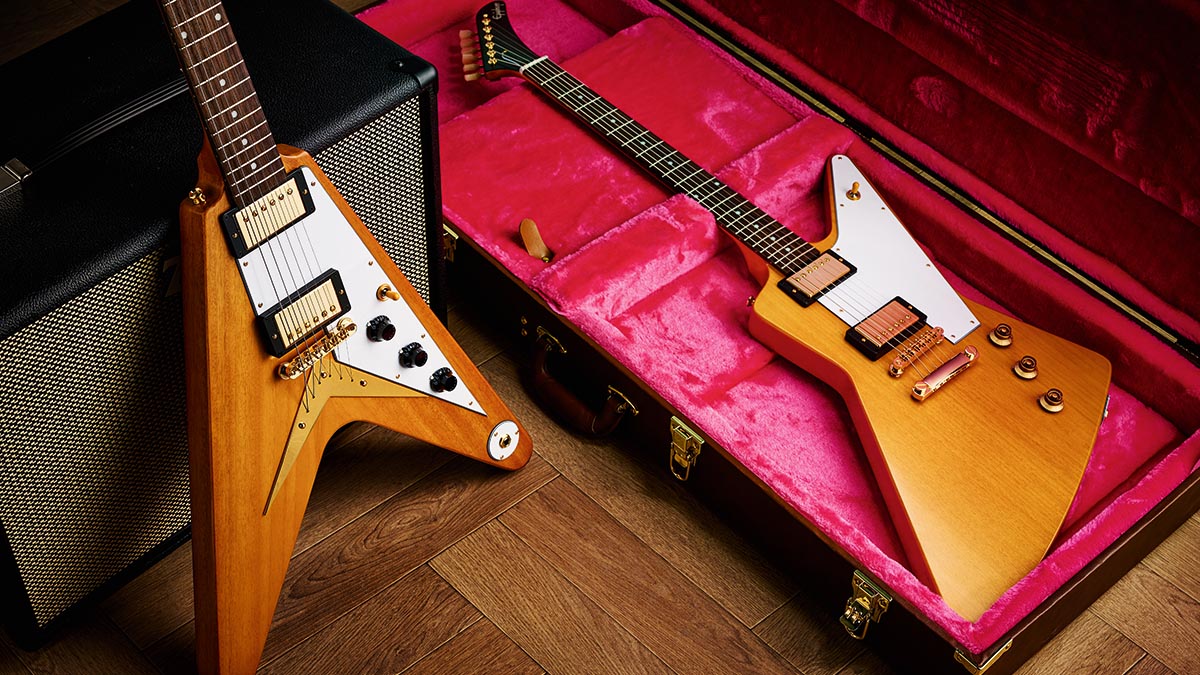Guitar World Verdict
The Explorer is a stunning recreation of a classic, with ballsy sounds that are worth way more than the modest asking price, and great playability. The Flying V is fabulous looking, evoking a vibe and era like almost no other guitar – and it has great authentic blues-rock tones, too.
Pros
- +
Top quality builds with classy old-school aesthetics.
- +
Relatively lightweight for all that timber.
- +
Explorer is full-on, the V a little less strident.
- +
Both have great necks and are superbly playable.
Cons
- -
Not at this price.
You can trust Guitar World
When in 1958 Gibson president Theodore ‘Ted’ McCarty designed the ES-335 and its siblings the ES-345 and ES-355, it was clear that his understanding of electric guitar design ran deep. The models were an instant success and their unbroken production from then until now has proved so in spades. How come, then, that in that very year the self-same designer dreamt up these two?
Other than the basic electronics, the Explorer and Flying V couldn’t have been more different. Of course, this was the ‘space age’ and Fender already had designs called Stratocaster and Telecaster that evoked cosmic adventure and all that was groundbreaking and modern. So it seemed Gibson was gunning for its share of this market, too.
But while 300-series sales soared, the Flying V didn’t make it off the runway, and the Explorer hardly got beyond the doors of 225 Parsons Street, Kalamazoo, the manufacturer’s legendary Michigan home.
True, the mighty Albert King used a V, but apparently only because it was languishing in a guitar store, he was offered it for a good price and being symmetrically shaped he could simply flip it upside down. Jazz guitarist and musical innovator Alvino Rey is said to have played an Explorer, too. Otherwise, the pointy pair looked destined for the dustbin of posterity.
However, moving on, as the guitar world invariably does, and things panned out rather differently. When the company’s then discontinued Les Paul fell into the hands of blues-rock’s glitterati in the mid-’60s to become the guitar of the moment, the model’s own scarcity meant that guitarists sought out other Gibsons with the same powerful pickups and intuitive controls.
And while ES-335s and SGs tended to be the popular ‘second choice’, rhythm and blues stalwarts Keith Richards and The Kinks’ Dave Davies, and bluesmen Lonnie Mack and Johnny Winter, fell for original ’58 Flying Vs. Eric Clapton used a 1958 Explorer during the 1970s, while Neil Young and Billy Gibbons have rocked both of these angular upstarts.
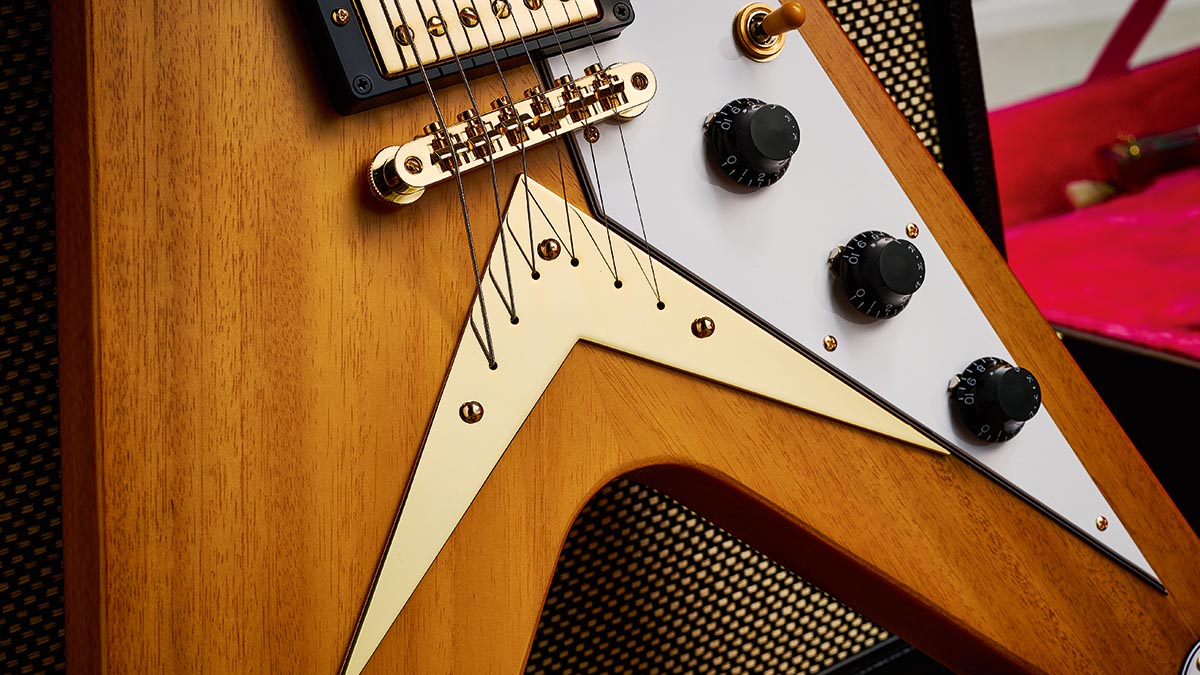
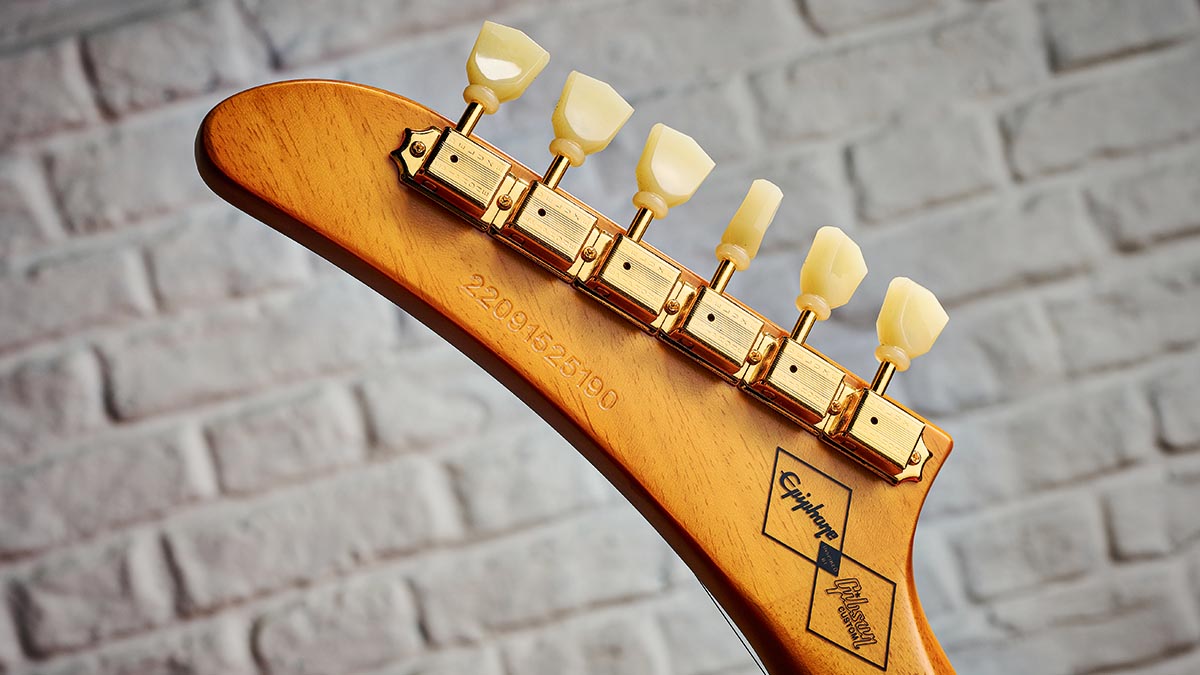
Today, so rare and sought-after have these models become that should you find a ’58 Flying V or Explorer lurking in your attic, you could trade it for a $300,000 Ferrari F8 Spider, should you so desire.
All the latest guitar news, interviews, lessons, reviews, deals and more, direct to your inbox!
So, 65 years on, at the crest of a phenomenal run of instruments, Epiphone has delivered faithful interpretations of these now iconic models at tempting price points. Let’s see how they stand up.
Construction-wise, they are simple affairs. Two pieces of solid korina make up the bodies, with a single piece forming the neck (the headstocks of both are discreetly scarfed on). On the original V, Gibson added a small lip that extended under the neck to help support it since there was little body wood either side to do so. Epiphone has aped this perfectly. Fingerboards are Indian laurel, an attractive rosewood substitute that’s finding its way onto many mid-range guitars.
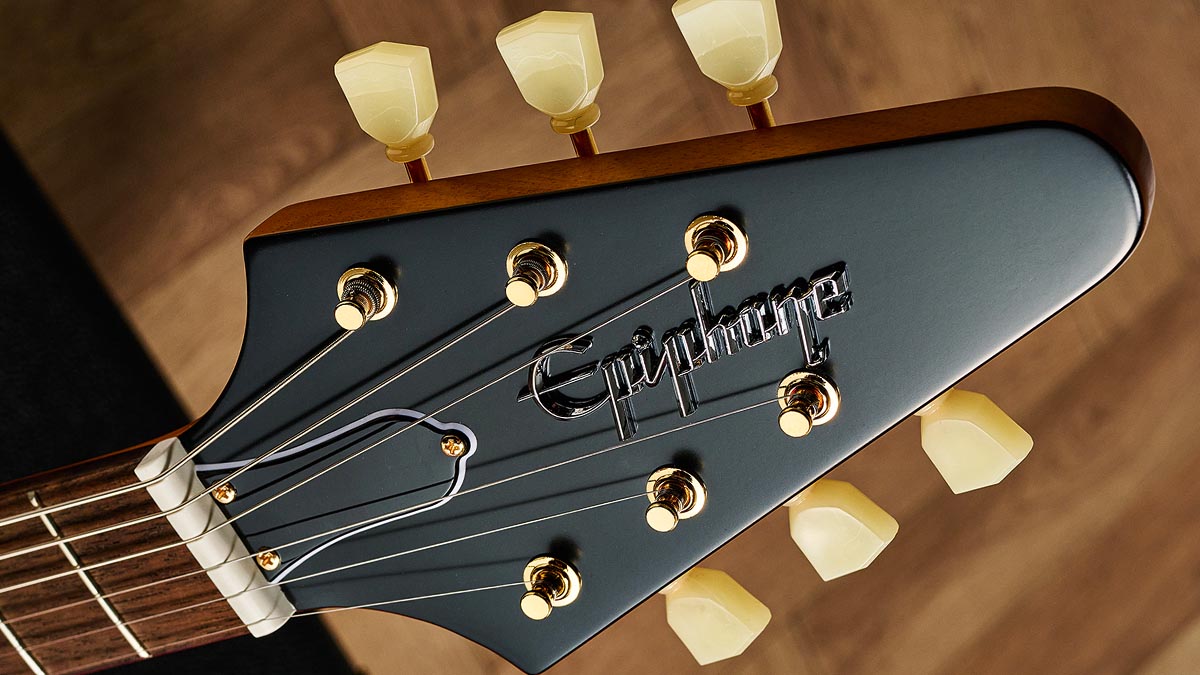
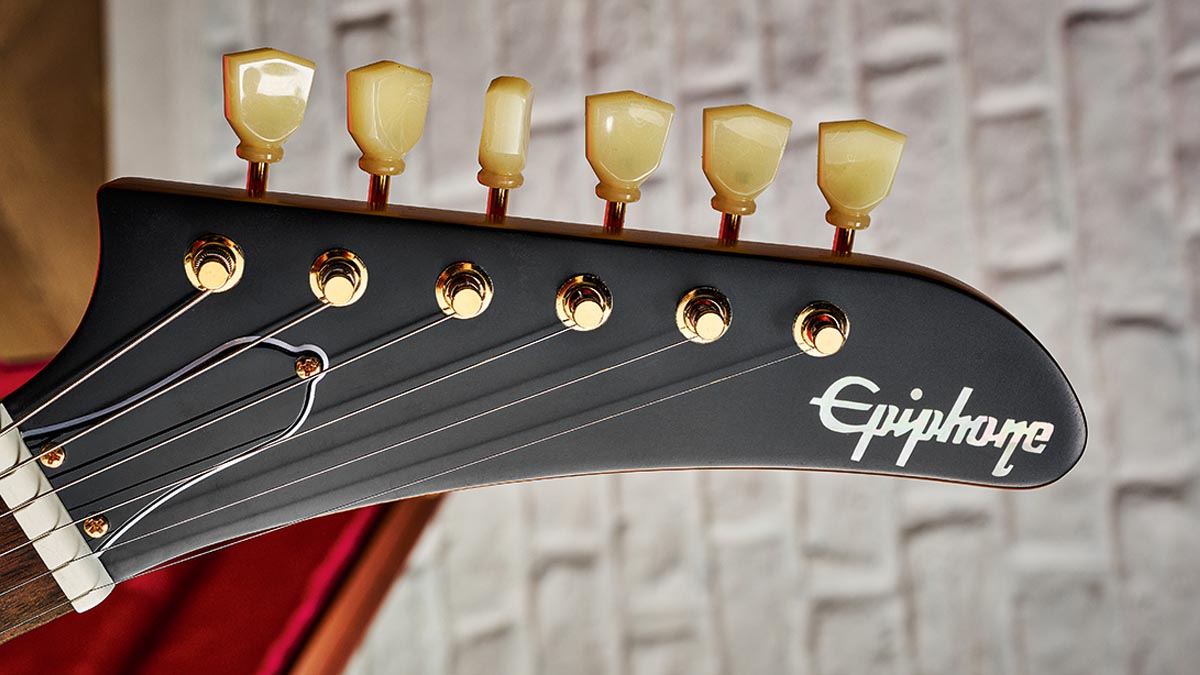
While the electronics of the two instruments are identical, their layouts, as dictated by each guitar’s individualistic outline, are very different. The Explorer’s three-way pickup selector is located on the protruding lower horn, while the Flying V’s sits adjacent to the neck pickup’s volume knob. Both guitars forego the usual separate tone control for each pickup, instead opting for a single master.
The V’s jack socket is found on a separate white circular plate at the tip of its lower ‘wing’, while the Explorer’s is on its expansive butt end – at the other extreme of which sits one strap button (the other is found on the body’s top ‘shoulder’, while on the V one is inside the top wing and the other positioned like its stablemate).
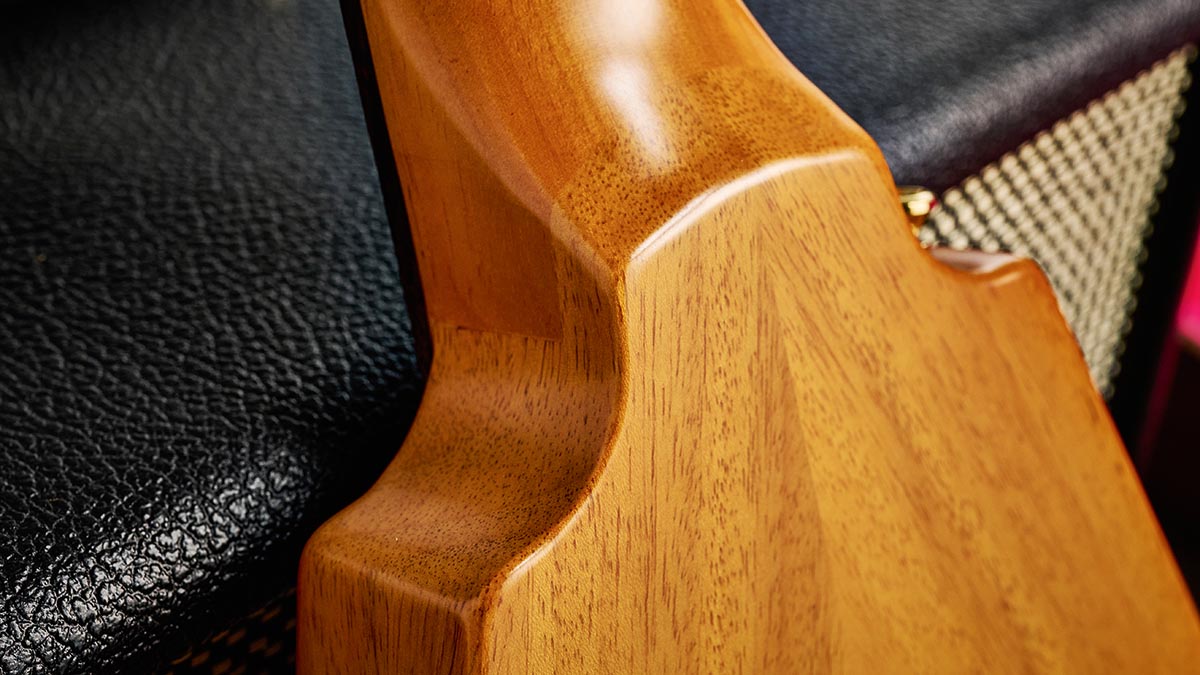
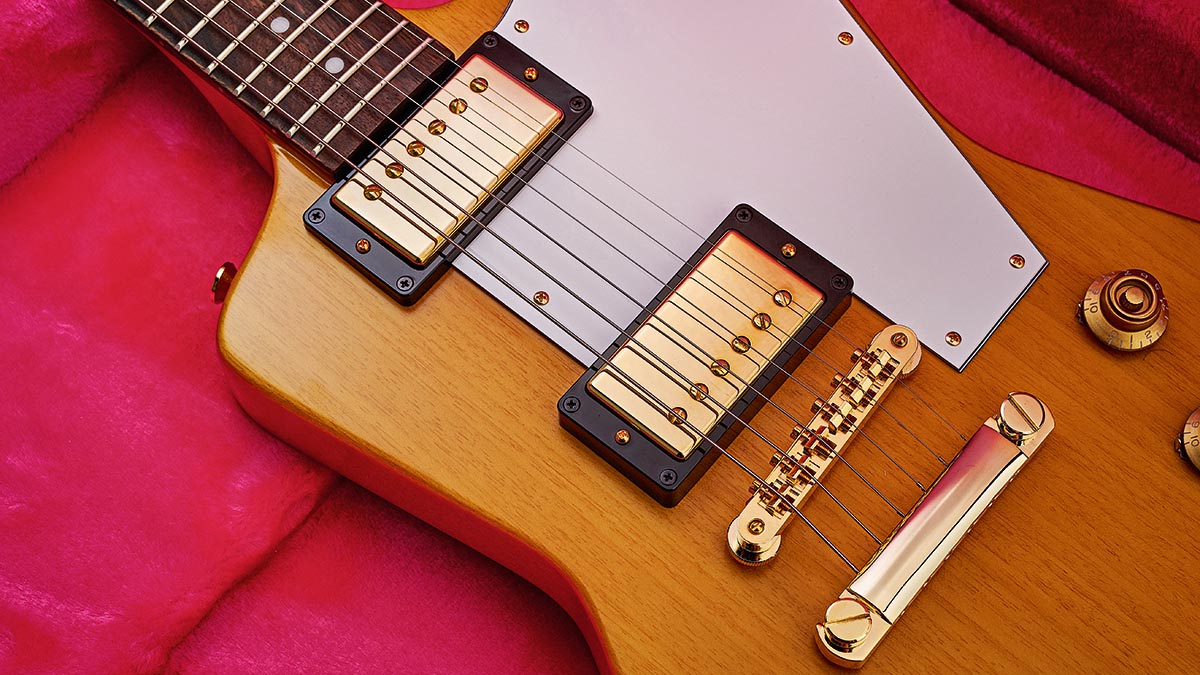
Our Explorer offers the conventional Gibson/Epiphone bridge and tailpiece array (the excellent LockTone tune-o-matic is found on both guitars), whereas the Flying V is strung via a delta-shaped metal plate through which the strings feed to six ferrules on the guitar’s rear.
Tuners on both instruments are Kluson-style Epiphone Deluxe with plastic ‘tulip’ buttons, while the company logo is inlaid in pearl on the Explorer, but it’s a stick-on plastic plate on the V – as it was with the ’50s original.
As mentioned, Epiphone hasn’t stinted when it comes to the electronics, with both V and Explorer sharing Gibson Burstbucker 2 (neck) and Burstbucker 3 (bridge) humbuckers, as well as CTS pots, Mallory capacitors, and Switchcraft three-way toggle and jack. All proper stuff.
Feel & Sounds
Due to their vast expanses of solid timber, you’d be forgiven for expecting our korina duo to weigh a ton. Far from it. It seems that when Gibson built the original models limba was chosen not only for its looks but for its lighter weight – certainly more so than the company’s usual first choice, mahogany.
It seems, too, that Gibson renamed the timber ‘korina’ as it sounded more exotic. At just 2.91kg (6.4lb) and 2.92kg (6.5lb), our Flying V and Explorer, despite their unwieldy size, sit comfortably around the neck with no balance issues; those strap button positions were well chosen.
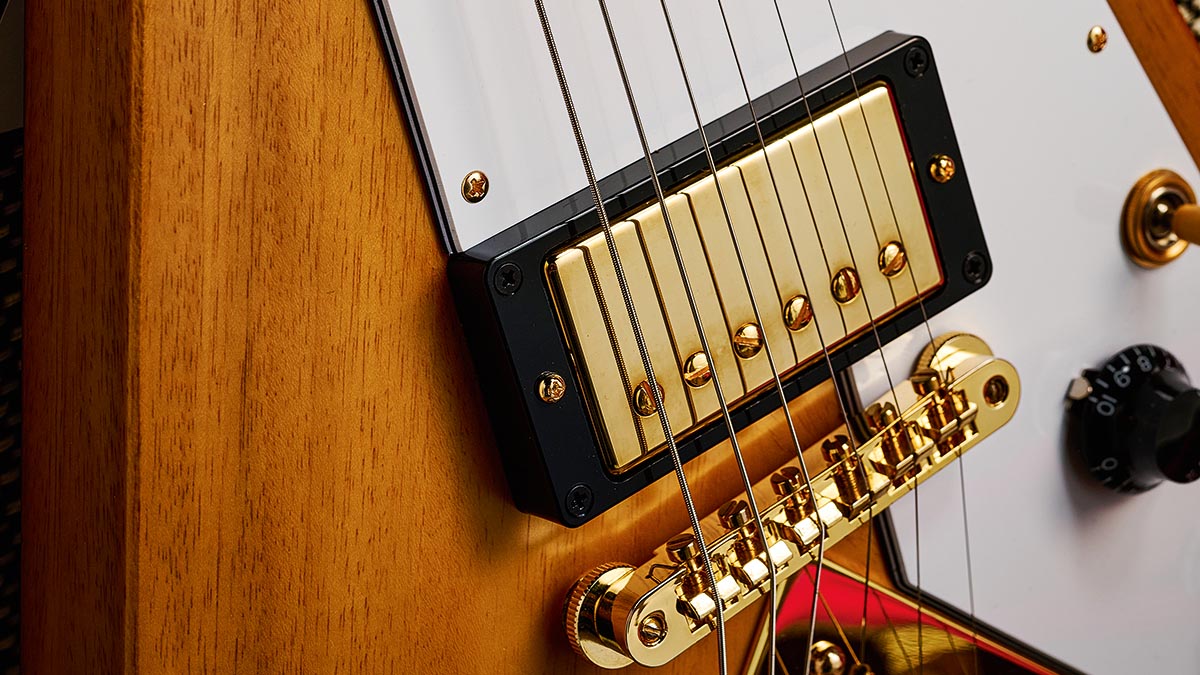
But even though our V carries the same rubber grip strip as the Gibson original, that’s supposed to stop it sliding off the leg when sitting down, it doesn’t work that brilliantly. But hey, is that the first thing on a guitarist’s mind when they choose something as outlandish‑looking as this?
Both guitars’ necks are all but identical. Patterned after the 1958 originals, they are a medium C that fits the palm beautifully. Of course, with the fingerboards almost totally exposed (the V’s a tad more so than that of the Explorer), high-end forays encounter no restrictions.
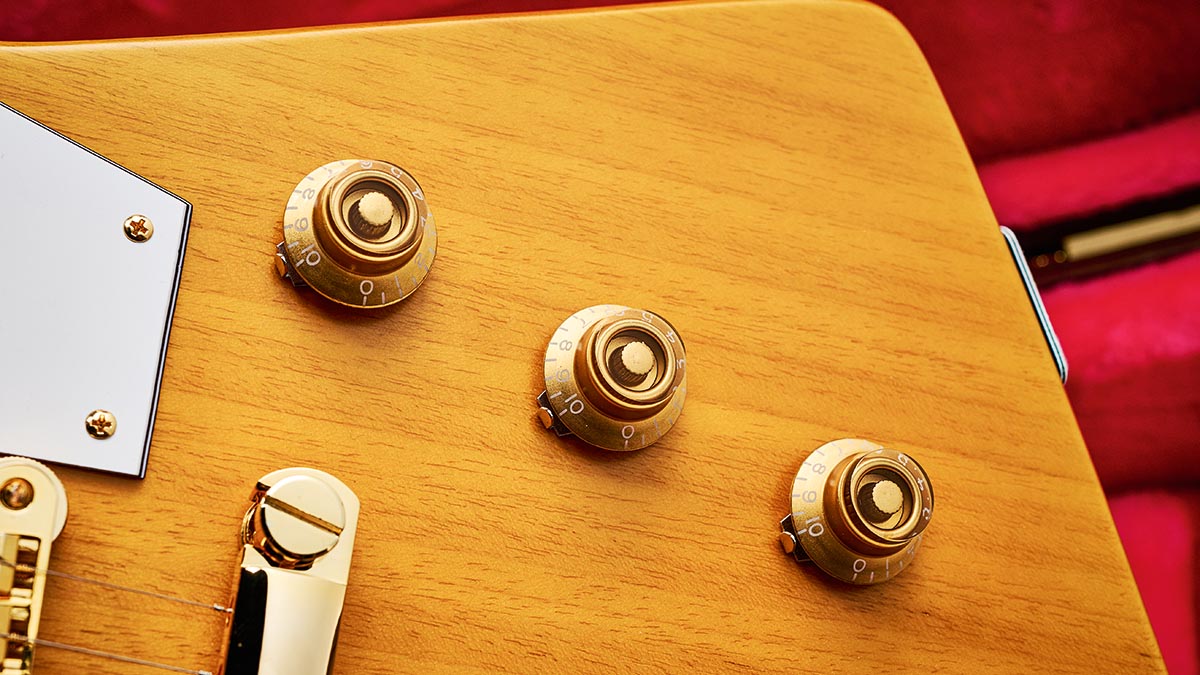
Those 22 medium jumbo frets and 305mm (12-inch) radius fingerboard afford effortless string bending and vibrato, the top wire providing an easy tone bend to the second octave.
Going from a Strat or Les Paul straight to either of these will require a certain amount of adjustment to your stance. But again, knowing how desperately cool you’re going to look, we suspect most players would put a little extra work in.
Sonically, with so much solid wood here and Gibson’s Burstbucker powertrains firing into a Marshall Origin 20, flat out on half power, we were expecting big tones. The Flying V went first and it was fat and punchy, classic Gibson raw power from the bridge pickup, flutey melodic notes from the neck and, in this case, instant Albert King with both Burstbuckers on.
With both full up but the neck unit knocked back to 8, it just gets huge. The guitar works exactly as you’d expect, other than that the master tone means you can’t truly preset each pickup and switch between very different tones and volumes.
Plugging in the Explorer and… wow, what’s this? Immediate controlled feedback and an instantly sharper and more ballsy tone. Same pickup heights and all other things being equal, could it simply be the Explorer’s classic bridge and tailpiece over the V’s through-stringing? The mass of each guitar will be slightly different, too, so perhaps that’s a factor. But in battle the Explorer does all that its arrow-shaped partner does but with a little added X factor. We weren’t expecting that!
Both guitars clean up superbly well. Backing off either volume control creates a set of warm and musical voices that belie the instruments’ aggressive image.
Verdict
Epiphone has hit bullseye again. Its collaboration with Gibson’s Custom Shop has really paid off, and the use of high-end components makes a big difference, too. These instruments evoke something that few others can. Their attitude is unparalleled, and the players that have taken to them number among the greatest to have ever trodden the boards.
Spare a thought for Ted McCarty: not only were his 1958 designs pure genius, in hindsight he was decades ahead of his time
While we loved them both, and the Flying V is the one that this particular reviewer would naturally warm to due to its associations, on the day the Explorer has just that little bit more. It’s not ‘better’, and you could say the V is the subtle one, and the Explorer is simply lacking in restraint. Different strokes for different folks, perhaps describes it best.
These guitars are causing a real stir and are sure not to hang around on shop walls like Albert King’s original allegedly did, especially at this price. So, if you can, we urge you to visit your friendly guitar store and try them both. And if you find yourself throwing shapes in front of the shop’s full-length mirror, perhaps spare a thought for Ted McCarty: not only were his 1958 designs pure genius, in hindsight he was decades ahead of his time.
Specs
Epiphone Korina 1958 Explorer
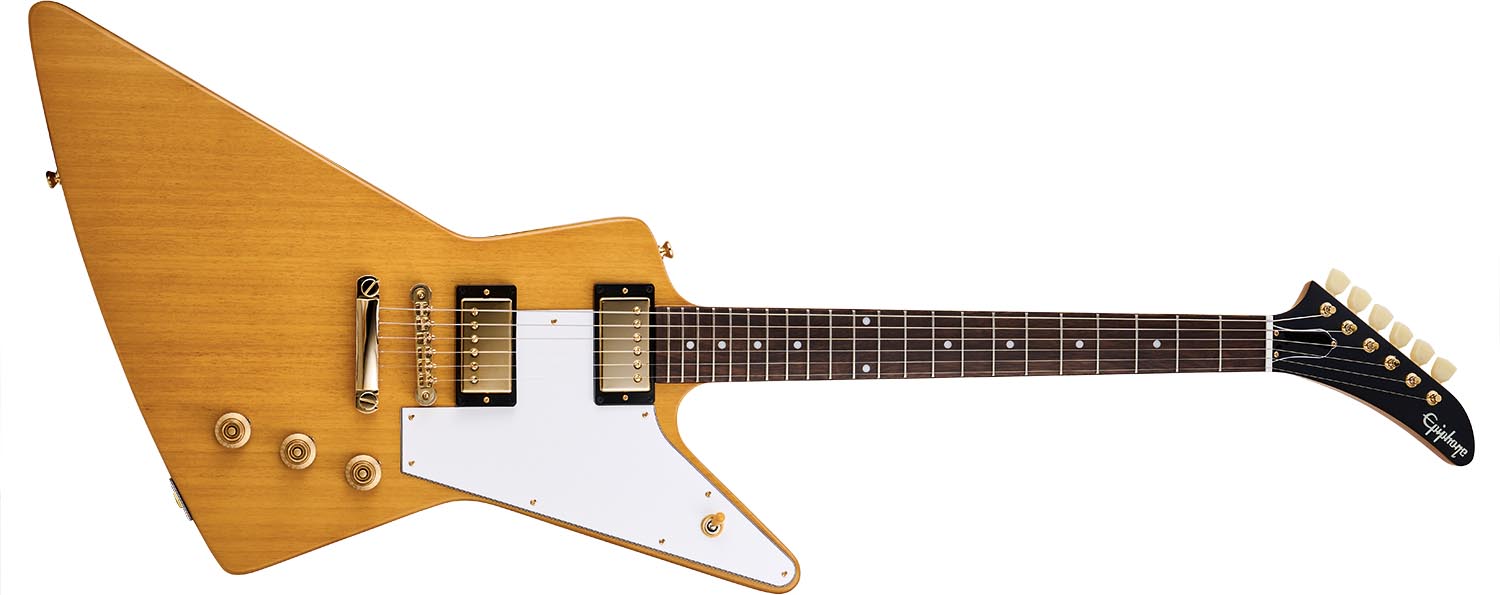
- PRICE: $1,299 / £1,219 (inc guitar case)
- ORIGIN: China
- TYPE: Offset solidbody electric
- BODY: 2-piece korina
- NECK: Korina, glued-in
- SCALE LENGTH: 628mm (24.75”)
- NUT/WIDTH: GraphTech/43.2mm
- FINGERBOARD: Indian laurel, 305mm (12”) radius
- FRETS: 22, medium jumbo
- HARDWARE: Gold-plated LockTone tune-o-matic ABR-1-style bridge and stud tailpiece, Epiphone Deluxe vintage-style tuners
- STRING SPACING, BRIDGE: 51.5mm
- ELECTRICS: Gibson Burstbucker 2 (neck) and Burstbucker 3 (bridge),
2x CTS volume pots and 1x CTS tone pot, Mallory capacitor, Switchcraft 3-way pickup selector and output jack - WEIGHT (kg/lb): 2.92/6.5
- OPTIONS: None
- RANGE OPTIONS: None
- LEFT-HANDERS: Yes
- FINISH: Aged Natural – satin
Epiphone Korina 1958 Flying V
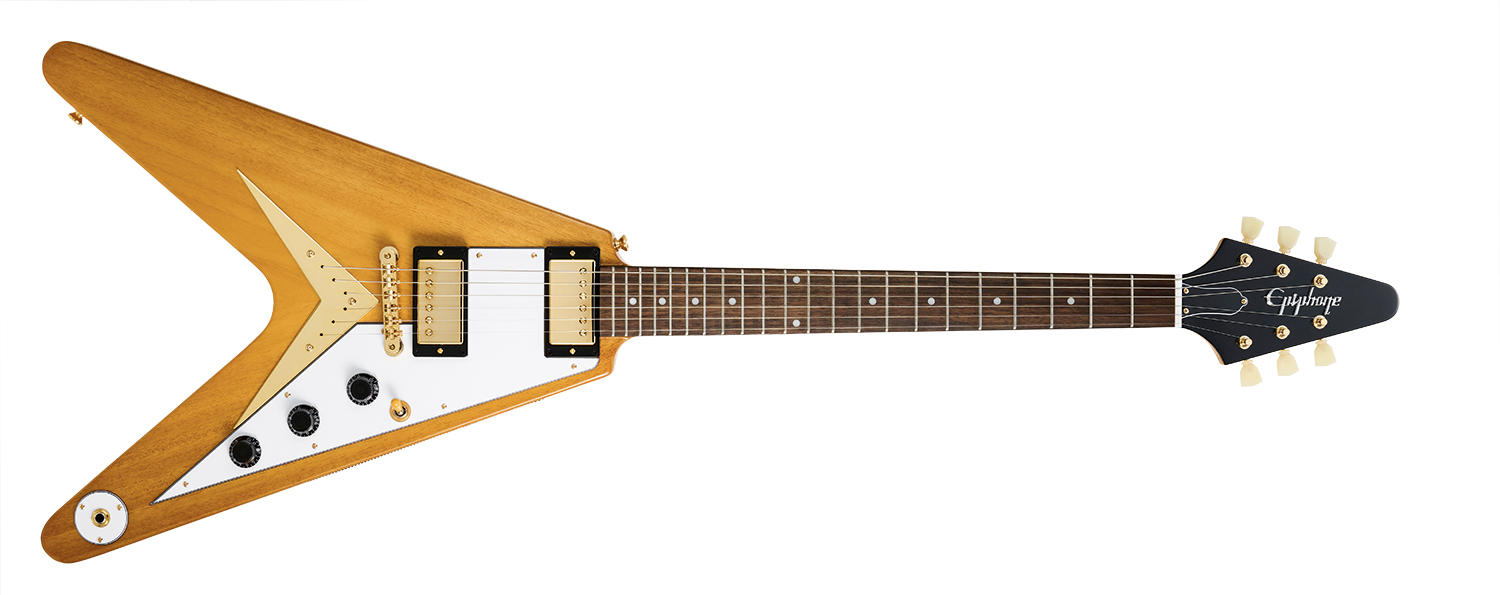
- PRICE: $1,299 / £1,219 (including case)
- ORIGIN: China
- TYPE: Offset solidbody electric
- BODY: 2-piece korina
- NECK: Korina, glued-in
- SCALE LENGTH: 628mm (24.75”)
- NUT/WIDTH: GraphTech/43.2mm
- FINGERBOARD: Indian laurel, 305mm (12”) radius
- FRETS: 22, medium jumbo
- HARDWARE: Gold-plated LockTone ABR-1-style tune-o-matic bridge and through-body stringing via gold V-shaped plate into rear ferrules, Epiphone Deluxe vintage-style tuners
- STRING SPACING, BRIDGE: 51.5mm
- ELECTRICS: Gibson Burstbucker 2 (neck) and Burstbucker 3 (bridge), 2x CTS volume pots and 1x CTS tone pot, Mallory capacitor, Switchcraft 3-way pickup selector and output jack
- WEIGHT (kg/lb): 2.91/6.4
- OPTIONS: N/A
- RANGE OPTIONS: N/A
- LEFT-HANDERS: Yes
- FINISH: Aged Natural – satin
- CONTACT: Epiphone
In the late '70s and early '80s Neville worked for Selmer/Norlin as one of Gibson's UK guitar repairers, before joining CBS/Fender in the same role. He then moved to the fledgling Guitarist magazine as staff writer, rising to editor in 1986. He remained editor for 14 years before launching and editing Guitar Techniques magazine. Although now semi-retired he still works for both magazines. Neville has been a member of Marty Wilde's 'Wildcats' since 1983, and recorded his own album, The Blues Headlines, in 2019.
